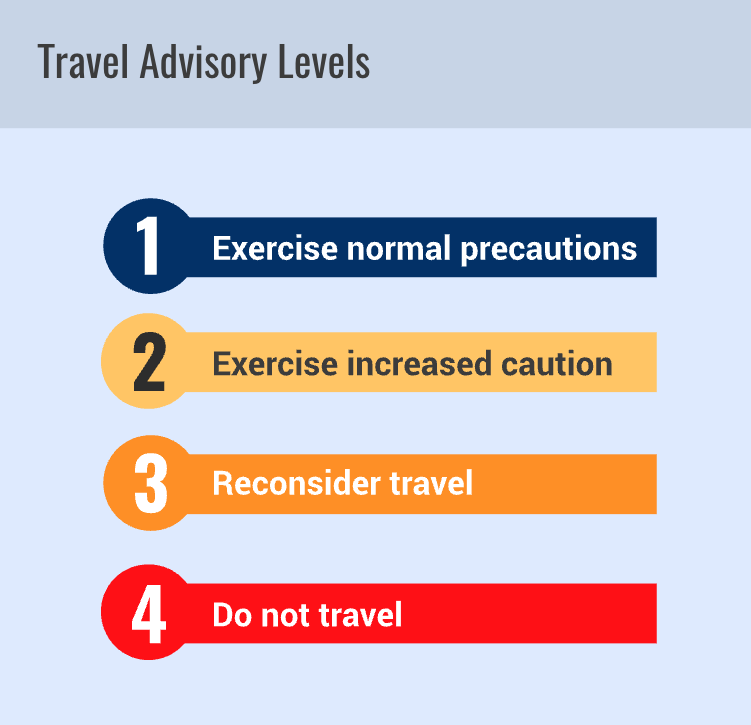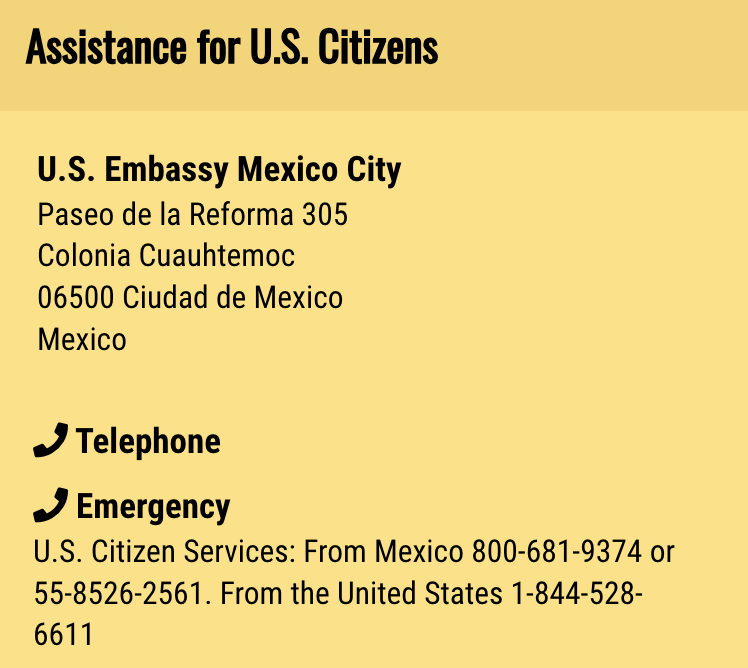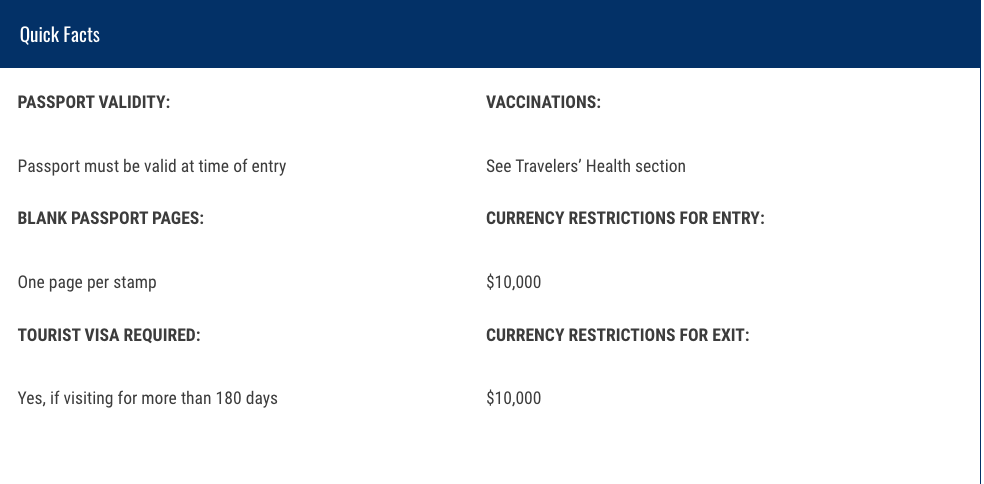Safety In Mexico – 2025
Travel Advisory Levels



Mexican States on the Level 4 - DO NOT TRAVEL Advisory List

Do Not Travel To:
- Colima state due to crime and kidnapping.
Do not travel due to crime and kidnapping.
Violent crime and gang activity are widespread. Most homicides are targeted assassinations against members of criminal organizations. Shooting incidents between criminal groups have injured or killed bystanders. U.S. citizens and LPRs have been victims of kidnapping.
Travel for U.S. government employees is limited to the following areas with noted restrictions:
- Manzanillo: U.S. government employee travel is limited to the tourist and port areas of Manzanillo.
- Employees traveling to Manzanillo from Guadalajara must use Federal Toll Road 54D during daylight hours.
To view a map of the restricted areas, visit https://mx.usembassy.gov/maps-of-restricted-areas
U.S. government employees may not travel to other areas of Colima state.
- Guerrero state due to crime.
Guerrero state – Do Not Travel
Do not travel due to crime.
Crime and violence are widespread. Armed groups operate independently of the government in many areas of Guerrero. Members of these groups frequently maintain roadblocks and may use violence towards travelers. U.S. citizens and LPRs have been victims of kidnapping in previous years.
U.S. government employees may not travel to any area in the state of Guerrero, including to tourist areas in Acapulco, Zihuatanejo, Taxco, and Ixtapa.
- Michoacan state due to crime.
Do not travel due to crime and kidnapping.
Crime and violence are widespread in Michoacan state.
Travel for U.S. government employees is limited to the following areas with the noted restrictions:- Federal Highway 15D: U.S. government employees may travel on Federal Highway 15D to transit the state between Mexico City and Guadalajara.
- Morelia: U.S. government employees may travel by air and by land using Federal Highways 43 or 48D from Federal Highway 15D.
- Lazaro Cardenas: U.S. government employees must travel by air only and limit activities to the city center or port areas.
To view a map of the restricted areas, visit https://mx.usembassy.gov/maps-of-restricted-areas
U.S. government employees may not travel to other areas of the state of Michoacan, including the portions of the Monarch Butterfly Reserve located in Michoacan.
- Sinaloa state due to crime.
Do not travel due to crime.
Violent crime is widespread. Criminal organizations are based in and operating in Sinaloa.
Travel for U.S. government employees is limited to the following areas with the noted restrictions:
- Mazatlan: U.S. government employees may travel to Mazatlan by air or sea only, are limited to the Zona Dorada and historic town center, and must travel via direct routes between these destinations and the airport and sea terminal.
- Los Mochis and Topolobampo: U.S. government employees may travel to Los Mochis and Topolobampo by air or sea only, are restricted to the city and the port, and must travel via direct routes between these destinations and the airport.
To view a map of the restricted areas, visit https://mx.usembassy.gov/maps-of-restricted-areas
U.S. government employees may not travel to other areas of Sinaloa state.
- Tamaulipas state due to crime and kidnapping.
Do not travel due to crime and kidnapping.
Organized crime activity – including gun battles, murder, armed robbery, carjacking, kidnapping, forced disappearances, extortion, and sexual assault – is common along the northern border and in Ciudad Victoria. Criminal groups target public and private passenger buses, as well as private automobiles traveling through Tamaulipas, often taking passengers and demanding ransom payments.
Heavily armed members of criminal groups often patrol areas of the state and operate with impunity particularly along the border region from Reynosa to Nuevo Laredo. In these areas, local law enforcement has limited capacity to respond to incidents of crime. Law enforcement capacity is greater in the tri-city area of Tampico, Ciudad Madero, and Altamira, which has a lower rate of violent criminal activity compared to the rest of the state. U.S. citizens and LPRs have been victims of kidnapping. U.S. citizens and LPRs have been victims of kidnapping.
Travel for U.S. government employees is limited to the following areas with the noted restrictions:
- Matamoros and Nuevo Laredo: U.S. government employees may only travel within a limited radius around and between the U.S. Consulates in Nuevo Laredo and Matamoros, their homes, the respective U.S. Ports of Entry, and limited downtown sites, subject to an overnight curfew.
- Overland travel in Tamaulipas: U.S. government employees may not travel between cities in Tamaulipas using interior Mexican highways. Travel between Nuevo Laredo and Monterrey is limited to Federal Highway 85D during daylight hours with prior authorization.
To view a map of the restricted areas, visit https://mx.usembassy.gov/maps-of-restricted-areas
U.S. government employees may not travel to other parts of Tamaulipas state.
- Zacatecas state due to crime and kidnapping.
Do not travel due to crime and kidnapping.
Violent crime, extortion, and gang activity are widespread in Zacatecas state. U.S. citizens and LPRs have been victims of kidnapping.
Travel for U.S. government employees is limited to the following areas with the noted restrictions:
- Zacatecas City: U.S. government employee travel is limited to Zacatecas City proper, and employees may not travel overland to Zacatecas City.
- U.S. government employees may not travel to other areas of Zacatecas state.
Mexican States on the Level 3 - RECONSIDER TRAVEL Advisory List

Reconsider Travel To:
- Baja California state due to crime and kidnapping.
Reconsider travel due to crime and kidnapping.
Transnational criminal organizations compete in the border area to establish narco-trafficking and human smuggling routes. Violent crime and gang activity are common. Travelers should remain on main highways and avoid remote locations. Of particular concern is the high number of homicides in the non-tourist areas of Tijuana. Most homicides appeared to be targeted; however, criminal organization assassinations and territorial disputes can result in bystanders being injured or killed. U.S. citizens and LPRs have been victims of kidnapping.
U.S. government employees must adhere to the noted restrictions:
- Mexicali Valley: U.S. government employees should avoid the Mexicali Valley due to the heightened possibility of violence between rival cartel factions. The boundaries of the restricted area are: to the east, the Baja California/Arizona and Baja California/Sonora borders; to the south, from La Ventana (on Highway 5) due east to the Colorado River; to the west, Highway 5; and to the north, Boulevard Lazaro Cardenas/Highway 92/Highway 1 to Carretera Aeropuerto, from the intersection of Highway 1 and Carretera Aeropuerto due north to the Baja California/California border, and from that point eastward along the Baja California/California border.
- Travelers may use Highways 2 and 2D to transit between Mexicali, Los Algodones, and San Luis Rio Colorado during daylight hours. Travelers may also use Highways 1 and 8 to transit to and from the Mexicali Airport during daylight hours. Travel on Highway 5 is permissible during daylight hours.
To view a map of the restricted areas, visit https://mx.usembassy.gov/maps-of-restricted-areas
There are no other travel restrictions for U.S. government employees in Baja California state. These include high-traffic tourism areas of border and coastal communities, such as Tijuana, Ensenada, and Rosarito.
- Chiapas state due to crime.
Reconsider travel due to crime.
Criminal activity and violence may occur throughout the state.
U.S. government employees may not travel to the municipality of Ocozocoautla and to the following restricted areas in the southeastern region. All areas within the boundaries, including highway and roads unless specifically exempted, are restricted. East-Northeast Boundary: the eastern boundary follows the Mexican-Guatemalan border from the southern point on the Pacific coast, along the border, to the northern end point east of Netzahualcóyotl. Northern Boundary: from Netzahualcóyotl in a straight line southwest towards the northern limit of Ocosingo. Western Boundary: from Ocosingo in a straight-line south to El Ocote, from El Ocote in a straight-line west to San Francisco Pujiltic, from San Franciso Pujiltic southwest to just north of Mapastepec. South-Southwest Boundary: Highway 200 from Mapastepec to Tapachula. All towns along this highway are not restricted. The area to the north of highway 200 defines the southern boundary of the restricted area. From Tapachula, the restricted area boundary is north and east of the city limits and then extends southeast to the Pacific coast at Tres Hermanos San Isidro.
U.S. government employees may travel to Tapachula within the city limits and on Highway 225, from Port Chiapas to Tapachula, including the Tapachula Airport.
To view a map of the restricted areas, visit https://mx.usembassy.gov/maps-of-restricted-areas
- Chihuahua state due to crime and kidnapping.
Reconsider travel due to crime and kidnapping.
Violent crime and gang activity are common. Most homicides are targeted assassinations against members of criminal organizations. Battles for territory between criminal groups have resulted in violent crime in areas frequented by U.S. citizens and U.S. government employees, including restaurants and malls during daylight hours. Bystanders have been injured or killed in shooting incidents. U.S. citizens and LPRs have been victims of kidnapping.
U.S. government employee travel is limited to the following areas with the noted restrictions:
- Ciudad Juarez: U.S. government employees may travel to the area of Ciudad Juarez bounded to the east by Bulevar Independencia; to the south by De los Montes Urales/Avenida Manuel J Clouthier/Carretera de Juárez; to the west by Via Juan Gabriel/Avenida de los Insurgentes/Calle Miguel Ahumada/Francisco Javier Mina/Melchor Ocampo; and to the north by the U.S.-Mexico border. Direct travel to the Ciudad Juarez airport (officially called the Abraham González International Airport) and the factories located along Bulevar Independencia and Las Torres is permitted. Travel to San Jerónimo is permitted only through the United States via the Santa Teresa U.S. Port of Entry; travel via Anapra is prohibited.
U.S. government employees may only travel from Ciudad Juarez to the city of Chihuahua during daylight hours via Federal Highway 45, with stops permitted only at the Guardia Nacional División Caminos station, the Umbral del Milenio overlook area, the border inspection station at KM 35, and the shops and restaurants on Federal Highway 45 in the city of Ahumada.
- U.S. government employees may travel between Ciudad Juarez and Ascension via Highway 2.
- Nuevo Casas Grandes Area (including Nuevo Casas Grandes, Casas Grandes, Mata Ortiz, Colonia Juárez, Colonia LeBaron, Paquimé and San Buenaventura): U.S. government employees may travel to the Nuevo Casas Grandes area during daylight hours via Mexico Federal Highway 2, and subsequently Federal Highway 10, to Nuevo Casas Grandes. Employees are permitted to stay overnight in the cities of Nuevo Casas Grandes and Casas Grandes only.
- City of Chihuahua: U.S. government employees may travel at any time to the area of the city of Chihuahua bounded to the north by Avenida Transformación; to the east by Avenida Tecnológico/Manuel Gómez Morín/Highway 16/Blvd.José Fuentes Mares; to the west by the city boundary; and to the south by Periférico Francisco R. Almada.
- U.S. government employees may travel on Highways 45, 16, and 45D through the city of Chihuahua and to the Chihuahua airport (officially called the General Roberto Fierro Villalobos International Airport).
- U.S. government employees may travel to Santa Eulalia to the east of the city of Chihuahua, as well as to Juan Aldama via Highway 16 to the northeast.
- U.S. government employees may travel south of the city of Chihuahua on Highway 45 to the southern boundary of Parral, including each town directly connected to Highway 45, including Lázaro Cárdenas, Pedro Meoqui, Santa Cruz de Rosales, Delicias, Camargo, Ciudad Jiménez, and Parral itself.
- U.S. government employees may only travel on official business from the city of Chihuahua on Highway 16 to Ciudad Cuauhtémoc bounded by Highway 21 to the north and east, Highway 5 to the west, and Bulevar Jorge Castillo Cabrera to the south.
- Ojinaga: U.S. government employees must travel to Ojinaga via U.S. Highway 67 and enter through the U.S. Port of Entry in Presidio, Texas.
- Palomas: U.S. government employees may travel to Palomas via U.S. highways through the U.S. Port of Entry in Columbus, New Mexico, or via Highway 2 in Mexico.
To view a map of the restricted areas, visit https://mx.usembassy.gov/maps-of-restricted-areas
U.S. government employees may not travel to other areas of Chihuahua, including Copper Canyon.
- Guanajuato state due to crime.
Reconsider travel due to crime.
Gang violence, often associated with the theft of petroleum and natural gas from the state oil company and other suppliers, occurs in Guanajuato, primarily in the south and central areas of the state. Of particular concern is the high number of murders in the southern region of the state associated with cartel-related violence. U.S. citizens and LPRs have been victims of kidnapping.
U.S. government employees must adhere to the following travel restrictions:
- Areas south of Federal Highway 45D: U.S. government employees may not travel to the area south of and including Federal Highway 45D, Celaya, Salamanca, and Irapuato.
To view a map of the restricted areas, visit https://mx.usembassy.gov/maps-of-restricted-areas
There are no other restrictions on travel for U.S. government employees in Guanajuato state, which includes tourist areas in: San Miguel de Allende, Guanajuato City, and surrounding areas.
- Jalisco state due to crime and kidnapping.
Reconsider travel due to crime and kidnapping.
Violent crime and gang activity are common in parts of Jalisco state. In Guadalajara, territorial battles between criminal groups take place in tourist areas. Shooting incidents between criminal groups have injured or killed innocent bystanders. U.S. citizens and LPRs have been victims of kidnapping.
U.S. government employees must adhere to the following travel restrictions:
- Jalisco-Michoacan border and Federal Highway 110: U.S. government employees may not travel to the area between Federal Highway 110 and the Jalisco-Michoacan border, nor travel on Federal Highway 110 between Tuxpan, Jalisco, and the Michoacan border.
- Federal Highway 80: U.S. government employees may not travel on Federal Highway 80 south of Cocula.
To view a map of the restricted areas, visit
https://mx.usembassy.gov/maps-of-restricted-areasThere are no other restrictions on travel for U.S government employees in Jalisco state which includes tourist areas in: Guadalajara Metropolitan Area, Puerto Vallarta (including neighboring Riviera Nayarit), Chapala, and Ajijic.
- Morelos state due to crime and kidnapping.
Reconsider travel due to crime and kidnapping.
Violent crime and gang activity are common in parts of Morelos state. U.S. citizens and LPRs have been victims of kidnapping.
There are no restrictions on travel for U.S. government employees in Morelos state.
- Sonora state due to crime and kidnapping.
Reconsider travel due to crime and kidnapping.
Sonora is a key location used by the international drug trade and human trafficking networks. Violent crime is widespread. U.S. citizens and LPRs have been victims of kidnapping. Travelers should maintain a heightened level of awareness of their surroundings in all their travels in Sonora. Security incidents may occur in any area of Sonora.
U.S. government employees must adhere to the following travel restrictions:
- Travel between Hermosillo and Nogales: U.S. government employees may travel between the U.S. Ports of Entry in Nogales and Hermosillo during daylight hours via Federal Highway 15 only. U.S. government employees may not use ANY taxi services, public buses, nor ride-share applications due to a lack of secure vetting and/or dispatching procedures. Travelers should exercise caution and avoid unnecessary stops as security incidents, including sporadic, armed carjackings, and shootings have been reported along this highway during daylight hours. Travelers should have a full tank of gas and inform friends or family members of their planned travel.
- Nogales: U.S. government employees may not travel in the triangular area north of Avenida Tecnologico, west of Bulevar Luis Donaldo Colosio (Periferico), and east of Federal Highway 15D (Corredor Fiscal) and the residential areas to the east of Calle Plutarco Elias. U.S. government employees may not use any taxi services, public buses, nor ride-share applications in Nogales.
- Puerto Peñasco: U.S. government employees may travel between Puerto Peñasco and the Lukeville-Sonoyta U.S. Port of Entry during daylight hours via Federal Highway 8 only. They may not travel on any other route to Puerto Peñasco. U.S. government employees may not use ANY taxi services, public buses, nor ride-share applications in Puerto Peñasco. due to a lack of secure vetting and/or dispatching procedures and the danger of kidnapping and other violent crimes.
- Triangular region near Mariposa U.S. Port of Entry: U.S. government employees may not travel into or through the triangular region west of the Mariposa U.S. Port of Entry, east of Sonoyta, and north of Altar municipality.
- San Luis Rio Colorado, Cananea, and Agua Prieta: U.S. government employees may travel directly from the nearest U.S. Port of Entry to San Luis Rio Colorado, Cananea (via Douglas Port of Entry), and Agua Prieta, but may not go beyond the city limits. Travel is limited to daylight hours only. Travel between Nogales and Cananea via Imuris is not permitted. U.S. government employees may not use ANY taxi services, public buses, nor ride-share applications in these cities due to a lack of secure vetting and/or dispatching procedures and the danger of kidnapping and other violent crimes.
- Eastern and southern Sonora (including San Carlos Nuevo Guaymas and Alamos): U.S. government employees may not travel to areas of Sonora east of Federal Highway 17, the road between Moctezuma and Sahuaripa, and State Highway 20 between Sahuaripa and the intersection with Federal Highway 16. U.S. government employees may travel to San Carlos Nuevo Guaymas and Alamos; travel to Alamos is only permitted by air and within city limits. U.S. government employees may not travel to areas of Sonora south of Federal Highway 16 and east of Federal Highway 15 (south of Hermosillo), as well as all points south of Guaymas, including Empalme, Guaymas, Obregon, and Navojoa. U.S. government employees may not use ANY taxi services, public buses, nor ride-share applications in these areas due to a lack of secure vetting and/or dispatching procedures and the danger of kidnapping and other violent crimes.
To view a map of the restricted areas, visit https://mx.usembassy.gov/maps-of-restricted-areas
U.S. government employees may travel to other parts of Sonora state in compliance with the above restrictions, including tourist areas in: Hermosillo, Bahia de Kino, and Puerto Penasco.
Mexican States on the Level 2 - EXERCISE INCREASED CAUTION Advisory List

Exercise Increased Caution When Traveling To:
- Aguascalientes state due to crime.
Exercise increased caution due to crime.
Criminal activity and violence may occur throughout the state.
There are no restrictions on travel for U.S. government employees in Aguascalientes state.
- Baja California Sur state due to crime.
Exercise increased caution due to crime.
Criminal activity and violence may occur throughout the state.
There are no restrictions on travel for U.S. government employees in Baja California Sur state.
- Coahuila state due to crime.
Exercise increased caution due to crime.
Violent crime and gang activity occur in parts of Coahuila state.
U.S. government employees must adhere to the following travel restrictions:
- Zaragoza, Morelos, Jimenez, Villa Union, Guerrero, and Hidalgo municipalities: U.S. government employees may not travel to these municipalities.
- Piedras Negras, Allende, Nava, Ciudad Acuña: U.S. government employees must travel directly from the United States and observe a curfew from midnight to 6:00 a.m. in both cities.
To view a map of the restricted areas, visit https://mx.usembassy.gov/maps-of-restricted-areas
There are no other restrictions on travel for U.S. government employees in Coahuila state.
- Durango state due to crime.
Exercise increased caution due to crime.
Violent crime and gang activity are common in parts of Durango state.
U.S. government employees must adhere to the following travel restrictions:
- West and south of Federal Highway 45: U.S. government employees may not travel to this region of Durango state.
To view a map of the restricted areas, visit https://mx.usembassy.gov/maps-of-restricted-areas
There are no other restrictions on travel for U.S. government employees in Durango state.
- Hidalgo state due to crime.
Exercise increased caution due to crime.
Criminal activity and violence may occur throughout the state.
There are no restrictions on travel for U.S. government employees in Hidalgo state.
- Mexico City due to crime.
Exercise increased caution due to crime.
Both violent and non-violent crime occur throughout Mexico City. Use additional caution, particularly at night, outside of the frequented tourist areas where police and security patrol more routinely. Petty crime occurs frequently in both tourist and non-tourist areas.
There are no restrictions on travel for U.S. government employees in Mexico City.
- Mexico State due to crime and kidnapping.
Exercise increased caution due to crime and kidnapping.
Both violent and non-violent crime occur throughout Mexico State. Use additional caution in areas outside of the frequented tourist areas, although petty crime occurs frequently in tourist areas as well. U.S. citizens and LPRs have been victims of kidnapping.
There are no restrictions on travel for U.S. government employees in Mexico State.
- Nayarit state due to crime.
Exercise increased caution due to crime.
Criminal activity and violence may occur throughout Nayarit state.
There are no restrictions on travel for U.S government employees in Nayarit state.
- Nuevo Leon state due to crime.
Exercise increased caution due to crime.
Criminal activity and violence may occur throughout the state.
There are no restrictions on travel for U.S. government employees in Nuevo Leon state.
- Oaxaca state due to crime.
Exercise increased caution due to crime.
Criminal activity and violence occur throughout the state.
U.S. travelers are reminded that U.S. government employees must adhere to the following travel restrictions:
- Isthmus region: U.S. government employees may not travel to the area of Oaxaca bounded by Federal Highway 185D to the west, Federal Highway 190 to the north, and the Oaxaca-Chiapas border to the east. This includes the cities of Juchitan de Zaragoza, Salina Cruz, and San Blas Atempa.
- Federal Highway 200 northwest of Pinotepa: U.S. government employees may not use Federal Highway 200 between Pinotepa and the Oaxaca-Guerrero border.
To view a map of the restricted areas, visit https://mx.usembassy.gov/maps-of-restricted-areas
There are no restrictions on travel for U.S. government employees to other parts of Oaxaca state, which include tourist areas in: Oaxaca City, Monte Alban, Puerto Escondido, and Huatulco.
- Puebla state due to crime and kidnapping.
Exercise increased caution due to crime and kidnapping.
Criminal activity and violence may occur throughout the state. U.S. citizens and LPRs have been victims of kidnapping.
There are no restrictions on travel for U.S. government employees in Puebla state.
- Queretaro state due to crime.
Exercise increased caution due to crime.
Criminal activity and violence may occur throughout the state.
There are no restrictions on travel for U.S. government employees in Queretaro state.
- Quintana Roo state due to crime.
Exercise increased caution due to crime.
Criminal activity and violence may occur in any location, at any time, including in popular tourist destinations. While not directed at tourists, shootings between rival gangs have injured and killed innocent bystanders, including U.S. citizens. Violent crime, including homicides and assaults, has increased in Tulum.
There are no restrictions on travel for U.S. government employees in Quintana Roo state. Exercise increased caution after dark in Cancun, Playa del Carmen, and Tulum and remain in well-lit pedestrian streets and tourist zones.
- San Luis Potosi state due to crime and kidnapping.
Exercise increased caution due to crime and kidnapping.
Criminal activity and violence may occur throughout the state. U.S. citizens and LPRs have been victims of kidnapping.
There are no restrictions on travel for U.S. government employees in San Luis Potosi state.
- Tabasco state due to crime.
Exercise increased caution due to crime.
Criminal activity and violence may occur throughout the state.
There are no restrictions on travel for U.S. government employees in Tabasco state.
- Tlaxcala state due to crime.
Exercise increased caution due to crime.
Criminal activity and violence may occur throughout the state.
There are no restrictions on travel for U.S. government employees in Tlaxcala state.
- Veracruz state due to crime.
Exercise increased caution due to crime.
Violent crime and gang activity occur with increasing frequency in Veracruz, particularly in the center and south near Cordoba and Coatzacoalcos. While most gang-related violence is targeted, violence perpetrated by criminal organizations can affect bystanders. Impromptu roadblocks requiring payment to pass are common.
There are no restrictions on travel for U.S. government employees in Veracruz state.
Mexican States on the Level 1 - EXERCISE NORMAL PRECAUTIONS Advisory List

Exercise Normal Precautions When Traveling To:
- Campeche state
Exercise normal precautions.
There are no restrictions on travel for U.S. government employees in Campeche state.
- Yucatan state
Exercise normal precautions.
There are no restrictions on travel for U.S. government employees in Yucatan state, which include tourist areas in: Chichen Itza, Merida, Uxmal, and Valladolid.


